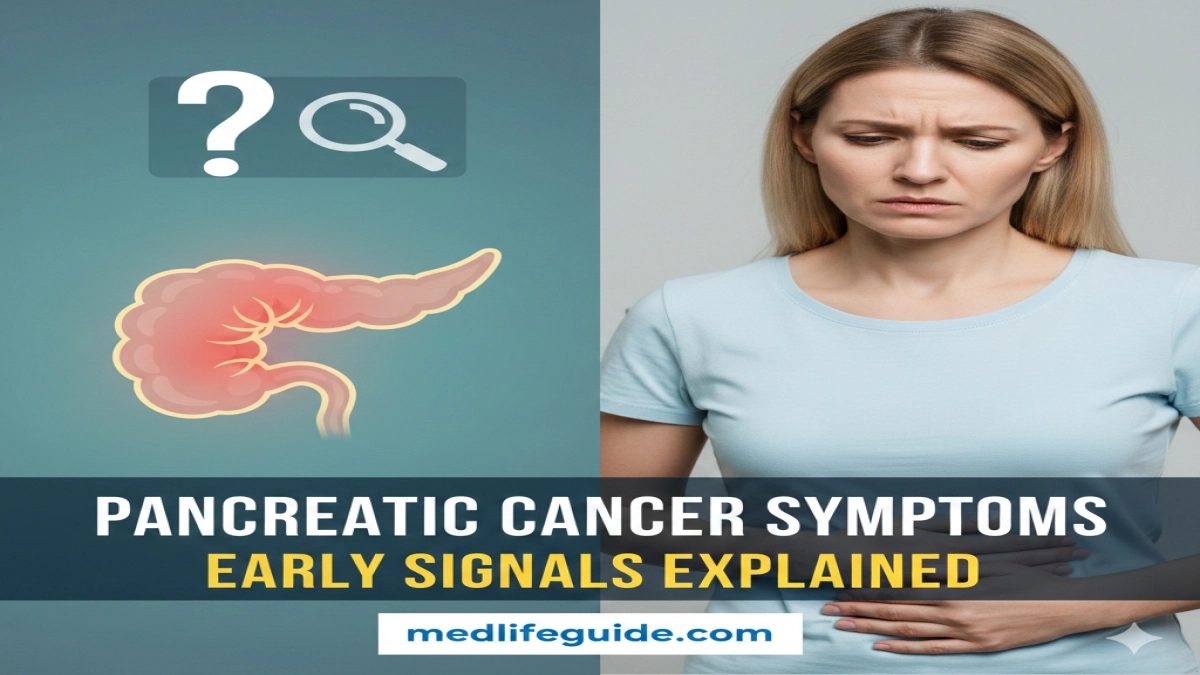Medically Reviewed and Compiled by Dr. Adam N. Khan, MD.
Pancreatic cancer is known for staying quiet until it reaches an advanced stage. The early signs often blend in with common digestive problems, which is why people miss them. Let’s break down how the symptoms show up, what they actually mean, and how to recognize the subtle changes that matter.
Early Symptoms
These signs often appear first, but they’re easy to overlook.
1. Upper Belly Discomfort
A dull, steady ache that sits in the upper abdomen. Some people say it “wraps around” to the back. This discomfort may get worse after eating or lying down.
2. Unexpected Weight Loss
People lose weight even when they’re eating normally. This happens because the pancreas stops making enough digestive enzymes, so the body can’t break down food well.
3. Loss of Appetite
A slow drop in appetite is common. Meals feel heavy or unappealing. Even small portions may cause fullness.
4. Changes in How You Digest Food
Gas, floating stools, or greasy stools can show up when the pancreas isn’t releasing enzymes.
Progressive or Advanced Symptoms
1. Jaundice
The whites of the eyes turn yellow first, then the skin. This happens when the tumor blocks the bile duct. Stool may look pale, and urine may turn dark.
2. Ongoing Fatigue
Tiredness grows even with good sleep. This comes from cancer-related weight loss, inflammation, and anemia.
3. Nausea and Vomiting
A growing tumor can press on the stomach, slowing how food moves through.
4. Blood Clots
Some people form clots in the legs or lungs before the cancer is even diagnosed. This is the body’s reaction to tumor-driven inflammation.
5. New-Onset Diabetes
Some patients with no history of blood sugar problems suddenly develop diabetes. The tumor disrupts insulin production.
Unique Clinical Takeaways
These are deeper points that help readers understand what is happening beneath the surface and why diagnosis can be so challenging.
1. Symptom Timing Often Follows Tumor Location
Tumors in different parts of the pancreas present differently.
• Head of the pancreas: jaundice shows up early because the bile duct is nearby.
• Body or tail: symptoms appear late since these areas don’t block major ducts until the cancer is large.
This is one major reason early detection is hard.
2. Digestive Symptoms May Show Before Pain
Many patients first notice subtle malabsorption: oily stools, bloating, and trouble digesting fats. These often appear weeks or months before classic abdominal pain. People treat them like “minor stomach issues,” which delays diagnosis.
3. New Diabetes in Adults Over 50 Needs Closer Attention
When someone over age 50 suddenly develops diabetes—especially with weight loss or digestive changes—pancreatic cancer should be part of the differential diagnosis. This clue is often overlooked in primary care.
When to See a Doctor
You should seek medical help if you notice:
• yellowing of eyes or skin
• steady upper belly pain that reaches the back
• unexplained weight loss
• new diabetes with other digestive changes
• pale stools or dark urine
Early evaluation matters. Blood tests, CT scans, MRIs, and endoscopic ultrasounds help doctors identify what is happening.
How Doctors Evaluate Symptoms
1. Blood Work
Liver tests, bilirubin levels, and tumor markers like CA 19-9 help build a picture, though the marker isn’t enough on its own.
2. Imaging
CT and MRI scans show structural changes in the pancreas and bile ducts.
3. Endoscopic Ultrasound
This test allows doctors to look closely at the pancreas and take biopsy samples.
4. Genetic and Risk Assessments
People with strong family history, chronic pancreatitis, or certain genetic syndromes may get monitored more closely.
Treatment Overview
While treatment depends on stage, most plans include:
• Surgery for early-stage tumors
• Chemotherapy
• Radiation in some cases
• Enzyme replacement therapy to help with digestion
Pain control and nutrition support also matter because weight loss and discomfort can become major issues.
Living With Pancreatic Cancer
Patients often deal with appetite changes, pain, emotional stress, and financial pressure from medical care. A strong care team—oncologists, dietitians, pain specialists, and mental health support—makes the path easier.
References and Citations
- National Cancer Institute (NCI) – Pancreatic Cancer Overview
- American Cancer Society – Signs and Symptoms of Pancreatic Cancer
- Johns Hopkins Medicine – Pancreatic Cancer Symptoms and Diagnosis
- Mayo Clinic – Pancreatic Cancer Clinical Facts
- New England Journal of Medicine – Pancreatic Cancer: Epidemiology and Clinical Features
Medical Disclaimer
This article is for education only. It is not a substitute for medical advice, diagnosis, or treatment. Always talk to a qualified healthcare professional about your health concerns.

